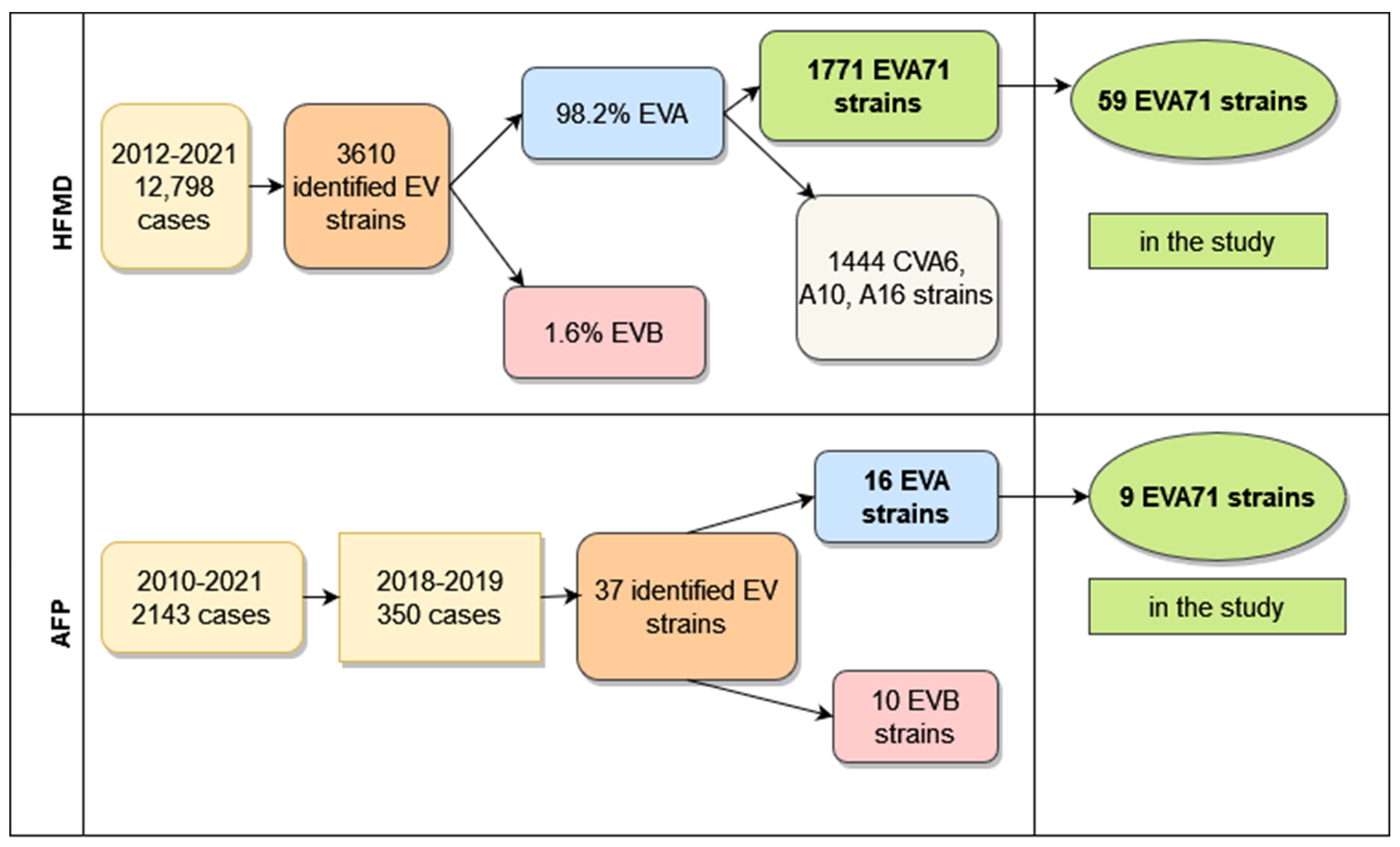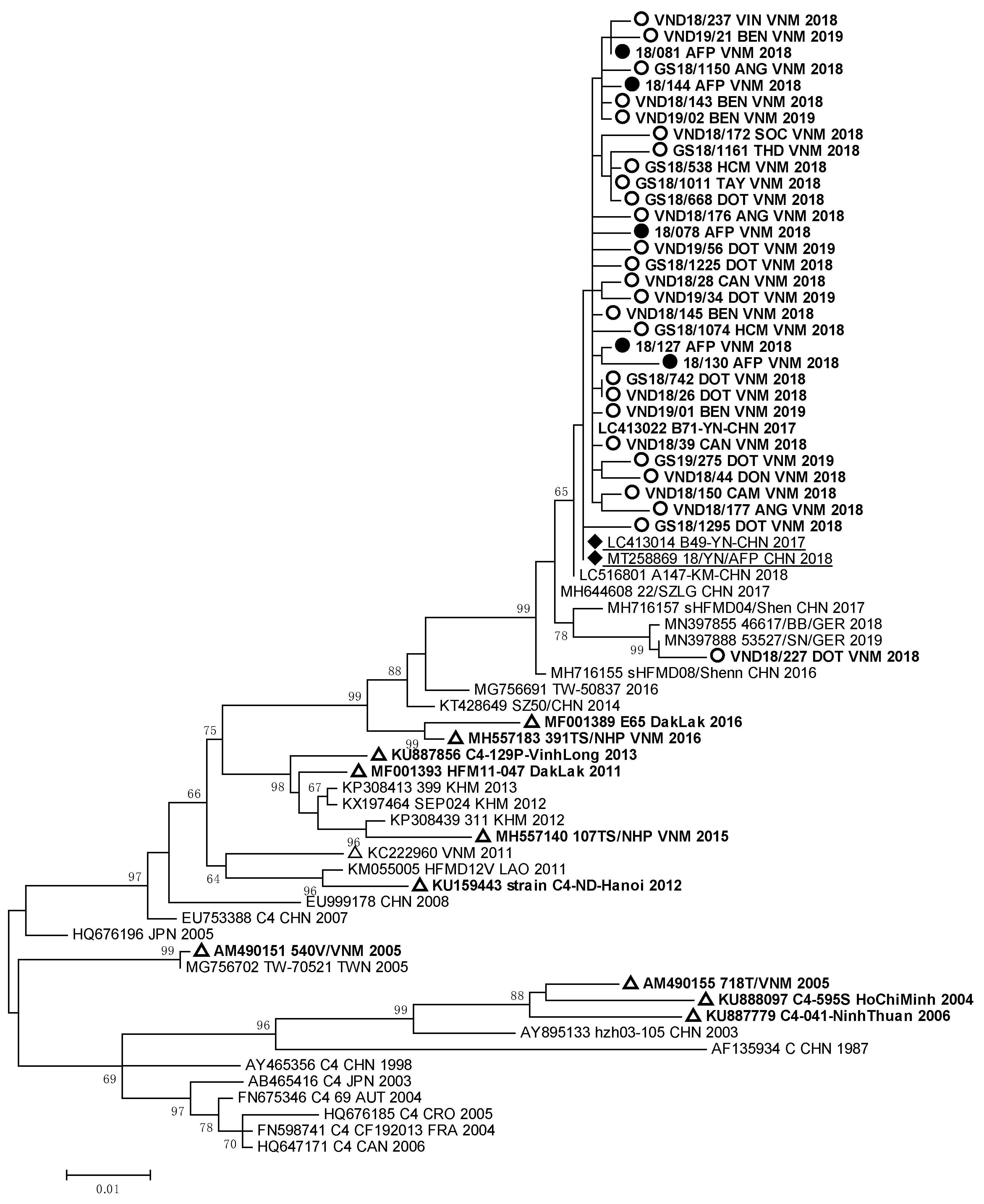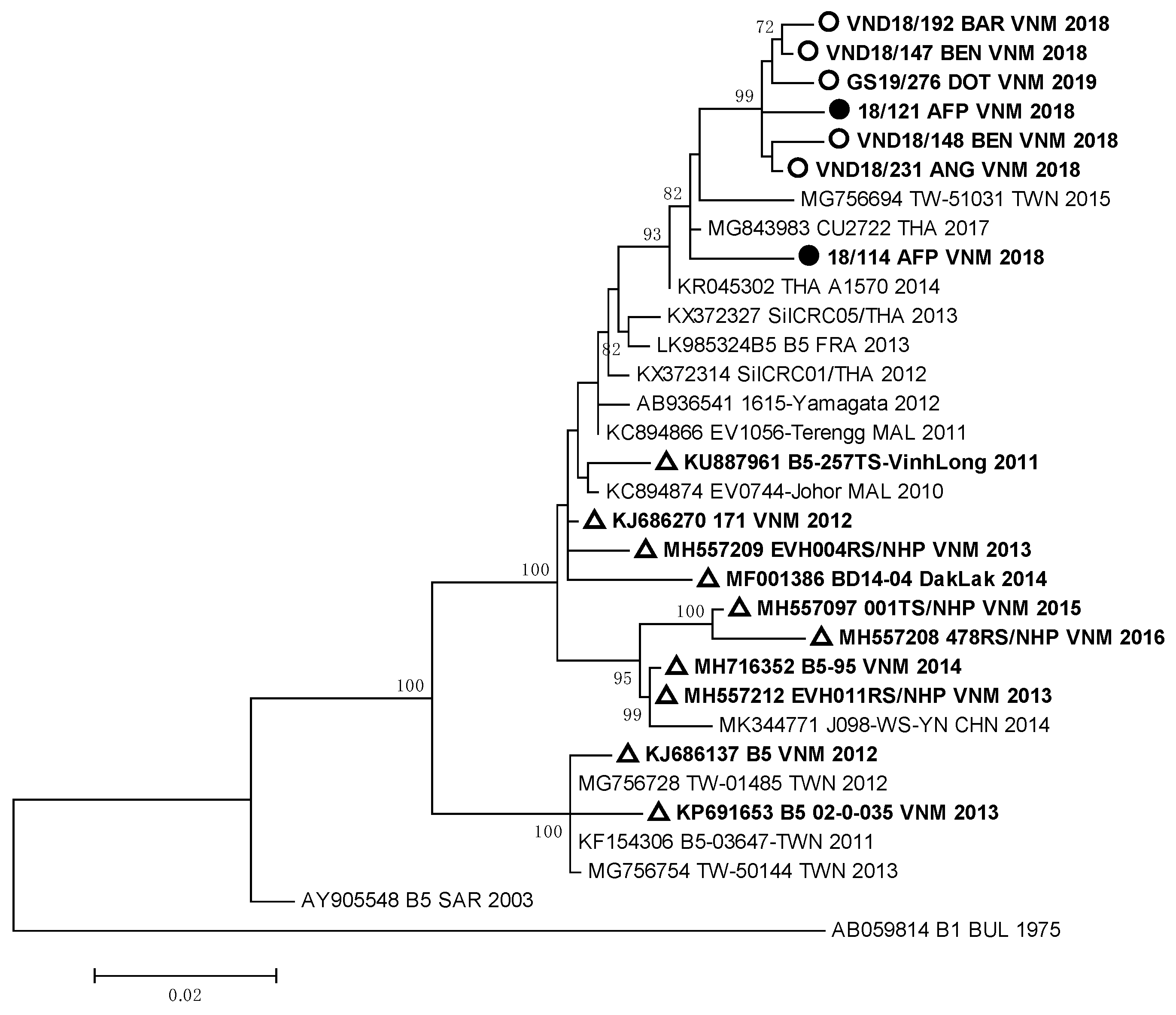Enterovirus 71-Associated Infection in South Vietnam: Vaccination Is a Real Solution
Abstract
1. Introduction
2. Materials and Methods
2.1. Study Design
2.2. Virological and Serological Methods
2.3. Molecular Methods
2.4. Statistical Analysis
3. Results
3.1. Analysis of Long-Term Virological Surveillance of Different Clinical Forms of Enteroviral Infection
3.2. Non-Polio Enteroviruses Isolated from Hand-Foot-and-Mouth Disease Cases
3.3. Non-Polio Enteroviruses Isolated from Acute Flaccid Paralysis Cases
3.4. Comparative Analysis of EVA71 Strains Isolated from Patients with HFMD and AFP
4. Discussion
5. Conclusions
Author Contributions
Funding
Institutional Review Board Statement
Informed Consent Statement
Data Availability Statement
Conflicts of Interest
References
- Akhmadishina, L.V.; Govorukhina, M.V.; Kovalev, E.V.; Nenadskaya, S.A.; Ivanova, O.E.; Lukashev, A.N. Enterovirus A71 Meningoencephalitis Outbreak, Rostov-on-Don, Russia, 2013. Emerg. Infect. Dis. 2015, 21, 1440–1443. [Google Scholar] [CrossRef] [PubMed]
- Bian, L.; Gao, F.; Mao, Q.; Sun, S.; Wu, X.; Liu, S.; Yang, X.; Liang, Z. Hand, foot, and mouth disease associated with coxsackievirus A10: More serious than it seems. Expert Rev. Anti-infective Ther. 2019, 17, 233–242. [Google Scholar] [CrossRef]
- Donato, C.; Hoi, L.T.; Hoa, N.T.; Hoa, T.M.; Van Duyet, L.; Ngan, T.T.D.; Van Kinh, N.; Trung, N.V.; Vijaykrishna, D. Genetic characterization of Enterovirus 71 strains circulating in Vietnam in 2012. Virology 2016, 495, 1–9. [Google Scholar] [CrossRef] [PubMed]
- Golitsyna, L.; Zverev, V.; Selivanova, S.; Ponomareva, N.; Kashnikov, A.; Sozonov, D.; Sashina, T.; Epifanova, N.; Evplova, I.; Rezaykin, A.; et al. Etiological Structure of Enterovirus Infections in the Russian Federation in 2017–2018. Public Health Life Environ. (PH&LE) 2019, 8, 30–38. [Google Scholar] [CrossRef]
- Lukashev, A.N.; Reznik, V.I.; Ivanova, O.E.; Eremeeva, T.P.; Karavianskaia, T.N.; Pereskokova, M.A.; Lebedeva, L.A.; Lashkevich, V.A.; Mikhaĭlov, M.I. Molecular epidemiology of virus ECHO 6—The etiological agent of men-ingitis outbreak in Khabarovsk in 2006. Vopr. Virusol. 2008, 53, 16–21. [Google Scholar] [PubMed]
- Lukashev, A.N.; Ivanova, O.E.; Eremeeva, T.P.; Gmyl, L.V. Analysis of echovirus 30 isolates from Russia and new independent states revealing frequent recombination and reemergence of ancient lineages. J. Clin. Microbiol. 2008, 46, 665–670. [Google Scholar] [CrossRef]
- Nguyen, N.T.; Pham, H.; Hoang, C.Q.; Nguyen, T.M.; Nguyen, L.T.; Phan, H.C.; Phan, L.T.; Vu, L.N.; Minh, N.N.T. Epidemiological and clinical characteristics of children who died from hand, foot and mouth disease in Vietnam, 2011. BMC Infect. Dis. 2014, 14, 341. [Google Scholar] [CrossRef]
- Nguyen, T.T.; Vu, T.T.; Phạm, M.T.; Tran, Q.K.; Hoang, Q.C. Circulation of Coxsackievirus a in Handfoot-Mouth Disease in Southern Vietnam, 2015–2016. Russ. J. Infect. Immun. 2018, 8, 533. [Google Scholar] [CrossRef]
- Van Tu, P.; Thao, N.T.T.; Perera, D.; Truong, K.H.; Tien, N.T.K.; Thuong, T.C.; How, O.M.; Cardosa, M.J.; McMinn, P.C. Epidemiologic and Virologic Investigation of Hand, Foot, and Mouth Disease, Southern Vietnam, 2005. Emerg. Infect. Dis. 2007, 13, 1733–1741. [Google Scholar] [CrossRef]
- Romanenkova, N.I.; Rozaeva, N.R.; Bichurina, M.A.; Kanaeva, O.I.; Chkhyndzheriya, I.G.; Shishkina, L.V.; Madoyan, A.G.; Valdaitseva, N.V. Epidemiological aspects of enterovirus infection in the Russian Federation during the period of 2018–2019. J. Infectology 2021, 13, 108–116. [Google Scholar] [CrossRef]
- Romanenkova, N.I.; Golitsyna, L.N.; Nguyen, T.T.T.; Ponomareva, N.V.; Leonov, A.V.; Kanaeva, O.I.; Zverev, V.V.; Selivanova, S.G.; Rozaeva, N.R.; Luong, M.T.; et al. Epidemiological and etiological aspects of enterovirus infection in Russia and Vietnam. Russ. J. Infect. Immun. 2021, 11, 905–916. [Google Scholar] [CrossRef]
- Sun, H.; Gao, M.; Cui, D. Molecular characteristics of the VP1 region of enterovirus 71 strains in China. Gut Pathog. 2020, 12, 1–11. [Google Scholar] [CrossRef] [PubMed]
- Phan, C.H.; Nguyen, T.P.T.; Doan, N.M.Q.; Nguyen, T.T.T.; Nguyen, Q.H.; Tran, A.T.; Nguyen, Q.K.; Kiem, S.H.; Hoang, T.L.; Vu, T.H.T.; et al. Epidemiological characteristic of hand, foot and mouth disease in the south of Vietnam, 2010–2012. J. Prev. Med. 2013, T.23, 172. [Google Scholar]
- Thao, N.T.T.; Donato, C.; Trang, V.T.H.; Kien, N.T.; Trang, P.M.T.; Khanh, T.Q.; Nguyet, D.T.; Sessions, O.M.; Cuong, H.Q.; Lan, P.T.; et al. Evolution and Spatiotemporal Dynamics of Enterovirus A71 Subgenogroups in Vietnam. J. Infect. Dis. 2017, 216, 1371–1379. [Google Scholar] [CrossRef] [PubMed]
- Thoa, L.P.K.; Chiang, P.-S.; Khanh, T.H.; Luo, S.-T.; Dan, T.N.H.; Wang, Y.-F.; Thuong, T.C.; Chung, W.-Y.; Hung, N.T.; Wang, J.-R.; et al. Genetic and Antigenic Characterization of Enterovirus 71 in Ho Chi Minh City, Vietnam, 2011. PLoS ONE 2013, 8, e69895. [Google Scholar] [CrossRef] [PubMed]
- World Health Organization (WHO). Manual for the Virological Investigation of Polio, 4th ed.; WHO: Geneva, Switzerland, 2004; pp. 1–112.
- World Health Organization (WHO). A Guide to Clinical Management and Public Health Response for Hand, Foot and Mouth Disease (HFMD). 2011. Available online: https://apps.who.int/iris/handle/10665/207490?locale-attribute=en& (accessed on 8 February 2023).
- van der Avoort, H.G.; Hull, B.P.; Hovi, T.; A Pallansch, M.; Kew, O.M.; Crainic, R.; Wood, D.J.; Mulders, M.N.; van Loon, A.M. Comparative study of five methods for intratypic differentiation of polioviruses. J. Clin. Microbiol. 1995, 33, 2562–2566. [Google Scholar] [CrossRef]
- Crainic, R.; Couillin, P.; Blondel, B.; Cabau, N.; Boué, A.; Horodniceanu, F. Natural variation of poliovirus neutralization epitopes. Infect. Immun. 1983, 41, 1217–1225. [Google Scholar] [CrossRef]
- Nix, W.A.; Oberste, M.S.; Pallansch, M.A. Sensitive, Seminested PCR Amplification of VP1 Sequences for Direct Identification of All Enterovirus Serotypes from Original Clinical Specimens. J. Clin. Microbiol. 2006, 44, 2698–2704. [Google Scholar] [CrossRef]
- Oberste, M.S.; Maher, K.; Williams, A.J.; Dybdahl-Sissoko, N.; Brown, B.A.; Gookin, M.S.; Peñaranda, S.; Mishrik, N.; Uddin, M.; Pallansch, M.A. Species-specific RT-PCR amplification of human enteroviruses: A tool for rapid species identification of uncharacterized enteroviruses. J. Gen. Virol. 2006, 87, 119–128. [Google Scholar] [CrossRef]
- Kumar, S.; Stecher, G.; Tamura, K. MEGA 7: Molecular Evolutionary Genetics Analysis version 7.0. Mol. Biol. and Evol. 2016, 33, 1870–1874. [Google Scholar] [CrossRef]
- Böttcher, S.; Diedrich, S.; Keeren, K.; the Laboratory Network for Enterovirus Diagnostic (LaNED). Increased detection of enterovirus A71 infections, Germany, 2019. Eurosurveillance 2019, 24, 1900556. [Google Scholar] [CrossRef] [PubMed]
- Van, N.T.T.; Nguyen, V.T.T.; Nguyen, Q.H.; Pham, D.T. Molecular epidemiology analysis of enterovirus 71 strains isolated in Dak Lak, Vietnam, 2011–2016. J. Med. Virol. 2019, 91, 56–64. [Google Scholar] [CrossRef]
- Van Pham, H.; Hoang, T.N.A.; Duong, H.T.; Phan, L.T.; Phan, U.T.N.; Ho, N.X.; Hoang, C.Q. Clinical characteristics of hand, foot and mouth disease in Daklak Province, Vietnam and associated factors of severe cases. Virusdisease 2017, 28, 430–433. [Google Scholar] [CrossRef]
- Puenpa, J.; Auphimai, C.; Korkong, S.; Vongpunsawad, S.; Poovorawan, Y. Enterovirus A71 Infection, Thailand, 2017. Emerg. Infect. Dis. 2018, 24, 1386–1387. [Google Scholar] [CrossRef]
- Hoang, C.Q.; Nguyen, T.T.T.; Ho, N.X.; Nguyen, H.D.; Nguyen, A.B.; Nguyen, T.H.T.; Phan, H.C.; Phan, L.T. Transmission and serotype features of hand foot mouth disease in household contacts in Dong Thap, Vietnam. BMC Infect. Dis. 2019, 19, 933. [Google Scholar] [CrossRef]
- Nhan, L.N.T.; Khanh, T.H.; Hong, N.T.T.; Van, H.M.T.; Nhu, L.N.T.; Ny, N.T.H.; Nguyet, L.A.; Thanh, T.T.; Anh, N.T.; Hang, V.T.T.; et al. Clinical, etiological and epidemio-logical investigations of hand, foot and mouth disease in southern Vietnam during 2015–2018. PLoS Negl. Trop. Dis. 2020, 14, e0008544. [Google Scholar] [CrossRef]
- Hoang, C.Q.; Nguyen, H.D.; Ho, N.X.; Vu, T.H.T.; Pham, T.T.M.; Nguyen, K.T.; Hoang, L.T.; Clapham, H.; Nguyen, T.T.T.; Phan, L.T. Incidence of Infection of Enterovirus 71 and Coxsackieviruses A6 and A16 among Household Contacts of Index Cases in Dong Thap Province, Southern Vietnam. BioMed Res. Int. 2020, 2020, 9850351. [Google Scholar] [CrossRef] [PubMed]
- Van Hoang, M.T.; Nguyen, T.A.; Tran, T.T.; Vu, T.T.H.; Le, N.T.N.; Nguyen, T.H.N.; Le, T.H.N.; Nguyen, T.T.H.; Nguyen, T.H.; Le, N.T.N.; et al. Clinical and aetiological study of hand, foot and mouth disease in southern Vietnam, 2013–2015: Inpatients and outpatients. Int. J. Infect. Dis. 2019, 80, 1–9. [Google Scholar] [CrossRef]
- Mao, Q.; Cheng, T.; Zhu, F.; Li, J.; Wang, Y.; Li, Y.; Gao, F.; Yang, L.; Yao, X.; Shao, J.; et al. The Cross-Neutralizing Activity of Enterovirus 71 Subgenotype C4 Vaccines in Healthy Chinese Infants and Children. PLoS ONE 2013, 8, e79599. [Google Scholar] [CrossRef]
- Zhu, F.; Xu, W.; Xia, J.; Liang, Z.; Liu, Y.; Zhang, X.; Tan, X.; Wang, L.; Mao, Q.; Wu, J.; et al. Efficacy, Safety, and Immunogenicity of an Enterovirus 71 Vaccine in China. N. Engl. J. Med. 2014, 370, 829–832. [Google Scholar] [CrossRef]
- Zhu, F.C.; Meng, F.Y.; Li, J.X.; Li, X.L.; Mao, Q.Y.; Tao, H.; Zhang, Y.T.; Yao, X.; Chu, K.; Chen, Q.H.; et al. Efficacy, safety, and immunology of an inactivated al-um-adjuvant enterovirus 71 vaccine in children in China: A multicentre, randomised, double-blind, placebo-controlled, phase 3 trial. Lancet 2013, 381, 2024–2032. [Google Scholar] [CrossRef] [PubMed]
- Nguyen, T.T.; Chiu, C.-H.; Lin, C.-Y.; Chiu, N.-C.; Chen, P.-Y.; Le, T.T.V.; Le, D.N.; Duong, A.H.; Nguyen, V.L.; Huynh, T.N.; et al. Efficacy, safety, and immunogenicity of an inactivated, adjuvanted enterovirus 71 vaccine in infants and children: A multiregion, double-blind, randomised, placebo-controlled, phase 3 trial. Lancet 2022, 399, 1708–1717. [Google Scholar] [CrossRef] [PubMed]
- Huang, L.M.; Chiu, C.H.; Chiu, N.C.; Lin, C.Y.; Li, M.T.; Kuo, T.Y.; Weng, Y.J.; Hsieh, E.F.; Tai, I.C. Immunogenicity, safety, cross-reaction, and im-mune persistence of an inactivated enterovirus A71 vaccine in children aged from two months to 11 years in Taiwan. Vaccines 2019, 37, 1827–1835. [Google Scholar] [CrossRef] [PubMed]
- WHO. Recommendations to Assure the Quality, Safety and Efficacy of Enterovirus 71 Vaccines (Inactivated). 2020. Available online: https://www.who.int/publications/m/item/ev71-recommendationsdocs/default-source/biologicals/ecbs/post-ecbs-who-ev71-vaccinesrecommendations-final-3-nov-2020.pdf?sfvrsn=ce2ba6b5 (accessed on 8 February 2023).
- World Health Organization (WHO). List of Blueprint Priority Diseases. February 2018—Second Annual Review. Available online: https://www.who.int/blueprint/priority-diseases/en/ (accessed on 8 February 2023).



| Characteristics | Number of Patients | % |
|---|---|---|
| Age | ||
| 0–12 months | 19 | 21.8 |
| 13–35 months | 58 | 66.7 |
| 3–6 years | 10 | 11.5 |
| Gender | ||
| Male | 54 | 62.1 |
| Female | 33 | 37.9 |
| Severity Mild clinical form (buccal ulcer, skin rash) Complicated clinical form (buccal ulcer, skin rash, neurological, cardiovascular, respiratory, and paralytic symptoms) | ||
| 12 | 13.8 | |
| 75 | 86.2 | |
| Total | 87 | 100 |
| Characteristics | Number of Patients | % |
|---|---|---|
| Age | ||
| 0–12 months | 1 | 3.8 |
| 13–35 months | 17 | 65.4 |
| 3–14 years | 8 | 30.8 |
| Gender | ||
| Male | 17 | 65.4 |
| Female | 9 | 34.6 |
| Vaccination | ||
| Vaccinated (3 OPV doses) | 19 | 73.1 |
| Non-vaccinated | 7 | 26.9 |
| Total | 26 | 100 |
Disclaimer/Publisher’s Note: The statements, opinions and data contained in all publications are solely those of the individual author(s) and contributor(s) and not of MDPI and/or the editor(s). MDPI and/or the editor(s) disclaim responsibility for any injury to people or property resulting from any ideas, methods, instructions or products referred to in the content. |
© 2023 by the authors. Licensee MDPI, Basel, Switzerland. This article is an open access article distributed under the terms and conditions of the Creative Commons Attribution (CC BY) license (https://creativecommons.org/licenses/by/4.0/).
Share and Cite
Romanenkova, N.I.; Nguyen, T.T.T.; Golitsyna, L.N.; Ponomareva, N.V.; Rozaeva, N.R.; Kanaeva, O.I.; Leonov, A.V.; Novikova, N.A.; Bichurina, M.A. Enterovirus 71-Associated Infection in South Vietnam: Vaccination Is a Real Solution. Vaccines 2023, 11, 931. https://doi.org/10.3390/vaccines11050931
Romanenkova NI, Nguyen TTT, Golitsyna LN, Ponomareva NV, Rozaeva NR, Kanaeva OI, Leonov AV, Novikova NA, Bichurina MA. Enterovirus 71-Associated Infection in South Vietnam: Vaccination Is a Real Solution. Vaccines. 2023; 11(5):931. https://doi.org/10.3390/vaccines11050931
Chicago/Turabian StyleRomanenkova, Natalia I., Thi Thanh Thao Nguyen, Liudmila N. Golitsyna, Natalia V. Ponomareva, Nadezhda R. Rozaeva, Olga I. Kanaeva, Artem V. Leonov, Nadezhda A. Novikova, and Maina A. Bichurina. 2023. "Enterovirus 71-Associated Infection in South Vietnam: Vaccination Is a Real Solution" Vaccines 11, no. 5: 931. https://doi.org/10.3390/vaccines11050931
APA StyleRomanenkova, N. I., Nguyen, T. T. T., Golitsyna, L. N., Ponomareva, N. V., Rozaeva, N. R., Kanaeva, O. I., Leonov, A. V., Novikova, N. A., & Bichurina, M. A. (2023). Enterovirus 71-Associated Infection in South Vietnam: Vaccination Is a Real Solution. Vaccines, 11(5), 931. https://doi.org/10.3390/vaccines11050931





